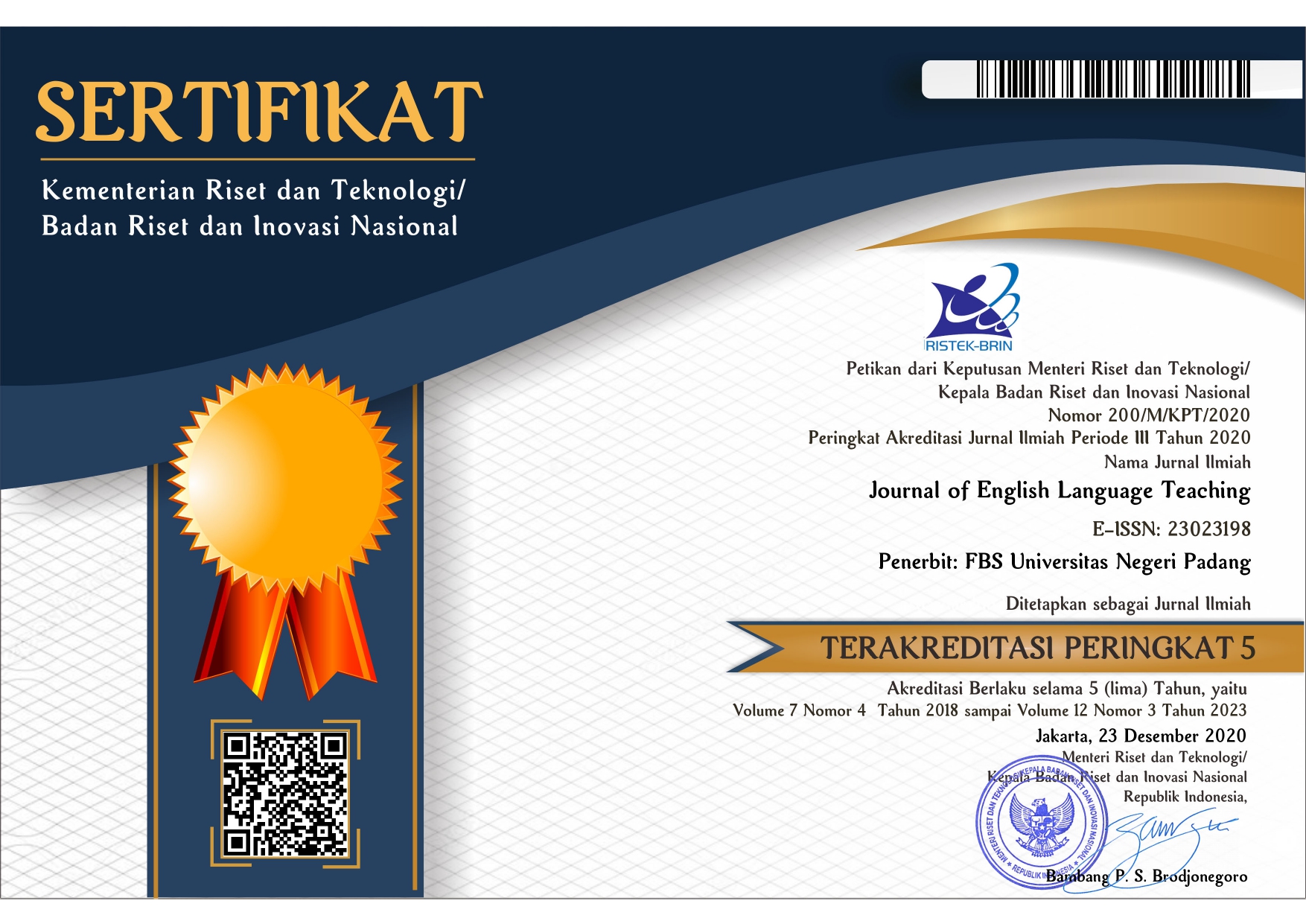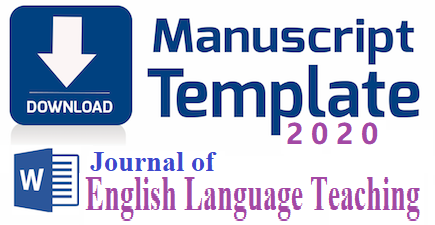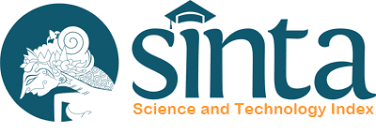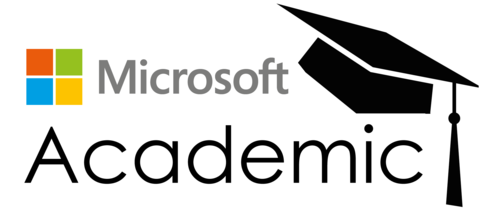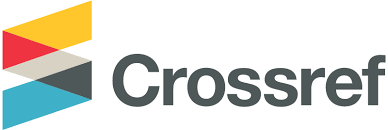The Accuracy and Acceptability of Students’ Post Editing of Idiomatic Expression Translation from English into Indonesia by Using U Dictionary
 ), Havid Ardi(2),
), Havid Ardi(2), (1) Universitas Negeri Padang
(2) Universitas Negeri Padang
 Corresponding Author
Corresponding Author
Copyright (c) 2023 Cici Prima Yeswari
DOI : https://doi.org/10.24036/jelt.v12i1.121840
Full Text:
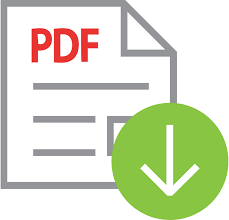 Language : en
Language : en
Abstract
Keywords
References
Aliurridha, A., & Tanjung, S. (2019). Post-Editing Proportion Of Google Translate In Informative And Expressive Texts. LEKSEMA: Jurnal Bahasa Dan Sastra, 4(1), 41–52.
Allen, J. (2003). Post-editing. Benjamins Translation Library, 35, 297–318.
Alwasilah, C. (1985). Linguistik suatu pengantar. Angkasa.
Andini, N. A. (2022). Comparing And Evaluating Students’understanding Of Idiom On Printed And Electronic Dictionaries In Social Science Majoring.
Ardi, H. (2018). Pengantar Penerjemahan (Introduction to Translation) [Preprint]. INA-Rxiv. https://doi.org/10.31227/osf.io/mwz2q
Ardi, H., Al Hafizh, Muhd., Rezqi, I., & Tuzzikriah, R. (2022). Can Machine Translations Translate Humorous Texts? Humanus, 21(1), 99. https://doi.org/10.24036/humanus.v21i1.115698
Catford, J. C. (1965). The Theory and Practice of Translation. Oxford University Press.
Çetiner, C., & İşisağ, K. U. (2019). Undergraduate level translation students’ attitudes towards machine translation post-editing training. International Journal of Languages’ Education and Teaching, 7(1), 110–120.
Cooper, T. C. (1998). Teaching Idioms. Foreign Language Annals, 31(2), 255–266. https://doi.org/10.1111/j.1944-9720.1998.tb00572.x
Daems, J., Vandepitte, S., Hartsuiker, R. J., & Macken, L. (2017). Identifying the machine translation error types with the greatest impact on post-editing effort. Frontiers in Psychology, 8, 1282.
Dulock, H. L. (1993). Research Design: Descriptive Research. Journal of Pediatric Oncology Nursing, 10(4), 154–157. https://doi.org/10.1177/104345429301000406
Ekalano, N. D. (2022). An Analysis Of Accuracy Level Of U-Dictionary In Bahasa Indonesia-English Translation.
Fitria, T. N. (2021). A review of machine translation tools: The translation’s ability. Language Circle: Journal of Language and Literature, 16(1), 162–176.
Harto, S., Hamied, F. A., Musthafa, B., & Setyarini, S. (2022). Exploring undergraduate students’ experiences in dealing with post-editing of machine translation. Indonesian Journal of Applied Linguistics, 11(3).
Harto, S., Musthafa, B., & Setyarini, S. (2020). Investigating distinctive problems observed in post-editing of machine translation output made by Indonesian undergraduate students. 682–688.
Juwita, J., Riadi, A., & Handayani, M. (2020). The Students’ Perception Of Using U-Dictionary In Learning Pronunciation At STBA Pontianak. Jurnal Ilmiah Spectral, 6(1), 041–051. https://doi.org/10.47255/spectral.v6i1.46
Koglin, A., & Cunha, R. (2019). Investigating the post-editing effort associated with machine-translated metaphors: A process-driven analysis. Journal of Specialised Translation, 31, 38–59.
McCarthy, M., & O’Dell, F. (2002). English idioms in use (Vol. 2). Cambridge University Press Cambridge.
Mossop, B. (2014). Revising and editing for translators. Routledge.
Nababan, M., Nuraeni, A., & Sumardiono. (2012). Pengembangan model penilaian kualitas terjemahan.
Newmark, P. (1988). A textbook of translation. Prentice-Hall International.
Nida, E. A., & Taber, C. R. (1982). The Theory and Practice of Translation. With Special Reference to Bible Translating (Helps for Translators 8). E.J. Brill.
Pasaribu, R. R. (2022). An Analysis of the Accuracy Level of English to Indonesian Idiom Translation by Google Translate.
Pratama, R. A., & Damara, G. (2018). An analysis of idiomatic expression translation in school of rock movie. ELTR Journal, 2(1), 46–55.
Screen, B. (2019). What effect does post-editing have on the translation product from an end-user’s perspective. The Journal of Specialised Translation, 31, 133–157.
Setiawan, A., & Axelina, M. (2022). The English Students’ Perception in Using Google Translate and U–Dictionary at Translation Class. International Social Sciences and Humanities, 2(1), 1–6.
Sin-wai, C. (2016). The Future of Translation Technology (0 ed.). Routledge. https://doi.org/10.4324/9781315731865
Sipayung, K. T., Sianturi, N. M., Arta, I. M. D., Rohayati, Y., & Indah, D. (2021). Comparison of Translation Techniques by Google Translate and U-Dictionary: How Differently Does Both Machine Translation Tools Perform in Translating? Elsya : Journal of English Language Studies, 3(3), 236–245. https://doi.org/10.31849/elsya.v3i3.7517
Somers, H. (2003). Benjamins Translation Library. John Benjamins Publishing Company.
Sycz-Opoń, J., & Gałuskina, K. (2017). Machine translation in the hands of trainee translators-an empirical study.
Wagner, E. (1985). Post-editing SYSTRAN, a challenge for Commission Translators. Terminologie et Traduction, 3, 1–7.
Yamada, M. (2019). The impact of Google neural machine translation on post-editing by student translators. The Journal of Specialised Translation, 31, 87–106.
 Article Metrics
Article Metrics
 Abstract Views : 319 times
Abstract Views : 319 times
 PDF Downloaded : 81 times
PDF Downloaded : 81 times
Refbacks
- There are currently no refbacks.
Copyright (c) 2023 Cici Prima Yeswari

This work is licensed under a Creative Commons Attribution-NonCommercial 4.0 International License.

